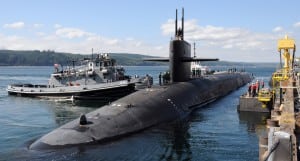This week Navy officials said they are trying to extend the lives of Ohio-class ballistic missile submarines (SSBNs) beyond the current 42-year service life to provide more schedule margin for the Columbia-class successor vessels.
“We have programs in place to extend the lives of submarines as much as we technically can. We’re already extending the life of the [Ohio] class to over 40 years of service. This is a testament to the way we designed the ship, the toughness that we built into the ship, and to the way the ships were maintained over the lives of these hulls.,” Adm. James Caldwell, director of Naval Nuclear Propulsion Program, said during the virtual annual Naval Submarine League symposium on Nov. 16.

The Ohio-class submarines were originally planned to have a service life of 30 years that was extended to 42 years.
“While it’s not possible to extend the entire class any further, we are looking at individual hulls to see if we can gain additional months or even a few years to allow us to have a greater flexibility in meeting…[Strategic Command] requirements as we transition to Columbia,” he continued.
Navy officials acknowledge the Columbia-class program has a tight timeline with little room for error. The first submarine is expected to be delivered in FY 2027 and be out on patrol by FY 2031.
Rear Adm. Ed Anderson, commander of undersea warfare, said his office was considering what kind of work is needed to extend the vessels’ lives.
“That’s a lot of really challenging engineering work and leveraging what we’re learning off the [Los Angeles-class submarines] for those,” Anderson said during the same event Monday.
He noted that while his office is set to refuel and extend the life of between five and seven Los Angeles-class attack submarines, they are decommissioning other Los Angeles-class boats. In that process, they are learning about the material conditions of parts and systems in the vessels, which will help the Navy extend the life of other submarines, like the Ohio-class submarines.
“We’re kind of tearing them apart, not to recycle them but to learn them and to figure out where are the highest risks and where the risks that we thought we had – are they really there. And then sustain Ohio through desired end of life,” Anderson continued.
“The hull, probably not a big deal; seawater systems, probably not the biggest deal; rotating machinery and internal supporting equipment, we’ve got a lot of work to do there. I’ll say our diesels are a key focus there, batteries are probably pretty well handled,” he said.
Anderson noted the Navy formed a diesel generator working group “a few years ago” and have since learned a lot about the Fairbanks Morse engines.
“We’ve learned a lot about how we should be operating them better, how we should maintain them better, how we can get predictive with that very old technology – we can use data with those too. And we’re improving those to the point of we’re doing a renewal of every SSBN diesel engine as every [ballistic missile submarine] comes through its last major availability.”
Anderson said the USS Louisiana (SSBN-743) during its engineered refueling overhaul (ERO) is itself getting a diesel renewal. The submarine first docked at the Puget Sound Naval Shipyard and Intermediate Maintenance Facility in September 2019 to start the two and a half year ERO.
“And as we refuel the Los Angeles-class we’re going to do the same thing. So this is part of preemptively generating positive [operational availability] for the fleet. Those diesels should be no maintenance problems.”
Columbia’s program executive officer (PEO) also said they welcome regaining additional margin wherever the Navy can get it.
“Production, early material procurement, how we can modify the build plan, whatever we got to go do to try to pull Columbia to the left, that’s our primary focus,” Rear Adm. Scott Pappano, PEO Columbia, said during the symposium on Tuesday.
“We’re submariners and we’re always looking to regain margin wherever we can on both sides of the spectrum, so I am not directly involved with the Ohio-class extension – I am aware that they are going on, but I think that that is a prudent thing to do – to say: hey, what is the art of the possible there? To say: if there are some of those unknown unknowns like COVID that we can’t battle our way through as effectively as we did here, you know, what is the Plan B if you will.”